Java高级特性增强-集合框架(LinkedList)
LinkedList 定义
LinkedList 是一个用链表实现的集合,元素有序且可以重复。
1 | public class LinkedList<E> |

和 ArrayList 集合一样,LinkedList 集合也实现了Cloneable接口和Serializable接口,分别用来支持克隆以及支持序列化。List 接口也不用多说,定义了一套 List 集合类型的方法规范。
注意,相对于 ArrayList 集合,LinkedList 集合多实现了一个 Deque 接口,这是一个双向队列接口,双向队列就是两端都可以进行增加和删除操作。
字段属性
1 | //链表元素(节点)的个数 |
注意这里出现了一个 Node 类,这是 LinkedList 类中的一个内部类,其中每一个元素就代表一个 Node 类对象,LinkedList 集合就是由许多个 Node 对象类似于手拉着手构成。1
2
3
4
5
6
7
8
9
10
11
12private static class Node<E> {
E item;//实际存储的元素
Node<E> next;//指向上一个节点的引用
Node<E> prev;//指向下一个节点的引用
//构造函数
Node(Node<E> prev, E element, Node<E> next) {
this.item = element;
this.next = next;
this.prev = prev;
}
}
如下图所示:
上图的 LinkedList 是有四个元素,也就是由 4 个 Node 对象组成,size=4,head 指向第一个elementA,tail指向最后一个节点elementD。
构造函数
1 | public LinkedList() { |
LinkedList 有两个构造函数,第一个是默认的空的构造函数,第二个是将已有元素的集合Collection 的实例添加到 LinkedList 中,调用的是 addAll() 方法,这个方法下面我们会介绍。
注意:LinkedList 是没有初始化链表大小的构造函数,因为链表不像数组,一个定义好的数组是必须要有确定的大小,然后去分配内存空间,而链表不一样,它没有确定的大小,通过指针的移动来指向下一个内存地址的分配。
添加元素
addFirst(E e)
将指定元素添加到链表头1
2
3
4
5
6
7
8
9
10
11
12
13
14
15//将指定的元素附加到链表头节点
public void addFirst(E e) {
linkFirst(e);
}
private void linkFirst(E e) {
final Node<E> f = first;//将头节点赋值给 f
final Node<E> newNode = new Node<>(null, e, f);//将指定元素构造成一个新节点,此节点的指向下一个节点的引用为头节点
first = newNode;//将新节点设为头节点,那么原先的头节点 f 变为第二个节点
if (f == null)//如果第二个节点为空,也就是原先链表是空
last = newNode;//将这个新节点也设为尾节点(前面已经设为头节点了)
else
f.prev = newNode;//将原先的头节点的上一个节点指向新节点
size++;//节点数加1
modCount++;//和ArrayList中一样,iterator和listIterator方法返回的迭代器和列表迭代器实现使用。
}
addLast(E e)和add(E e)
将指定元素添加到链表尾1
2
3
4
5
6
7
8
9
10
11
12
13
14
15
16
17
18
19
20//将元素添加到链表末尾
public void addLast(E e) {
linkLast(e);
}
//将元素添加到链表末尾
public boolean add(E e) {
linkLast(e);
return true;
}
void linkLast(E e) {
final Node<E> l = last;//将l设为尾节点
final Node<E> newNode = new Node<>(l, e, null);//构造一个新节点,节点上一个节点引用指向尾节点l
last = newNode;//将尾节点设为创建的新节点
if (l == null)//如果尾节点为空,表示原先链表为空
first = newNode;//将头节点设为新创建的节点(尾节点也是新创建的节点)
else
l.next = newNode;//将原来尾节点下一个节点的引用指向新节点
size++;//节点数加1
modCount++;//和ArrayList中一样,iterator和listIterator方法返回的迭代器和列表迭代器实现使用。
}
add(int index, E element)
将指定的元素插入此列表中的指定位置1
2
3
4
5
6
7
8
9
10
11
12
13
14
15
16
17
18
19
20
21
22
23
24
25
26
27
28
29
30
31
32
33
34
35
36
37
38
39
40
41
42
43
44
45//将指定的元素插入此列表中的指定位置
public void add(int index, E element) {
//判断索引 index >= 0 && index <= size中时抛出IndexOutOfBoundsException异常
checkPositionIndex(index);
if (index == size)//如果索引值等于链表大小
linkLast(element);//将节点插入到尾节点
else
linkBefore(element, node(index));
}
void linkLast(E e) {
final Node<E> l = last;//将l设为尾节点
final Node<E> newNode = new Node<>(l, e, null);//构造一个新节点,节点上一个节点引用指向尾节点l
last = newNode;//将尾节点设为创建的新节点
if (l == null)//如果尾节点为空,表示原先链表为空
first = newNode;//将头节点设为新创建的节点(尾节点也是新创建的节点)
else
l.next = newNode;//将原来尾节点下一个节点的引用指向新节点
size++;//节点数加1
modCount++;//和ArrayList中一样,iterator和listIterator方法返回的迭代器和列表迭代器实现使用。
}
Node<E> node(int index) {
if (index < (size >> 1)) {//如果插入的索引在前半部分
Node<E> x = first;//设x为头节点
for (int i = 0; i < index; i++)//从开始节点到插入节点索引之间的所有节点向后移动一位
x = x.next;
return x;
} else {//如果插入节点位置在后半部分
Node<E> x = last;//将x设为最后一个节点
for (int i = size - 1; i > index; i--)//从最后节点到插入节点的索引位置之间的所有节点向前移动一位
x = x.prev;
return x;
}
}
void linkBefore(E e, Node<E> succ) {
final Node<E> pred = succ.prev;//将pred设为插入节点的上一个节点
final Node<E> newNode = new Node<>(pred, e, succ);//将新节点的上引用设为pred,下引用设为succ
succ.prev = newNode;//succ的上一个节点的引用设为新节点
if (pred == null)//如果插入节点的上一个节点引用为空
first = newNode;//新节点就是头节点
else
pred.next = newNode;//插入节点的下一个节点引用设为新节点
size++;
modCount++;
}
addAll(Collection<? extends E> c)
按照指定集合的迭代器返回的顺序,将指定集合中的所有元素追加到此列表的末尾
此方法还有一个 addAll(int index, Collection<? extends E> c),将集合 c 中所有元素插入到指定索引的位置。其实
addAll(Collection<? extends E> c) == addAll(size, Collection<? extends E> c)
删除元素
删除元素和添加元素一样,也是通过更改指向上一个节点和指向下一个节点的引用即可.
remove()和removeFirst()
从此列表中移除并返回第一个元素
removeLast()
从该列表中删除并返回最后一个元素
remove(int index)
删除此列表中指定位置的元素
remove(Object o)
如果存在,则从该列表中删除指定元素的第一次出现
此方法本质上和 remove(int index) 没多大区别,通过循环判断元素进行删除,需要注意的是,是删除第一次出现的元素,不是所有的。
修改元素
通过调用 set(int index, E element) 方法,用指定的元素替换此列表中指定位置的元素。1
2
3
4
5
6
7
8public E set(int index, E element) {
//判断索引 index >= 0 && index <= size中时抛出IndexOutOfBoundsException异常
checkElementIndex(index);
Node<E> x = node(index);//获取指定索引处的元素
E oldVal = x.item;
x.item = element;//将指定位置的元素替换成要修改的元素
return oldVal;//返回指定索引位置原来的元素
}
这里主要是通过 node(index) 方法获取指定索引位置的节点,然后修改此节点位置的元素即可。
查找元素
getFirst()
返回此列表中的第一个元素
getLast()
返回此列表中的最后一个元素
get(int index)
返回指定索引处的元素
indexOf(Object o)
返回此列表中指定元素第一次出现的索引,如果此列表不包含元素,则返回-1。
遍历集合
普通for循环1
2
3
4
5
6
7
8LinkedList<String> linkedList = new LinkedList<>();
linkedList.add("A");
linkedList.add("B");
linkedList.add("C");
linkedList.add("D");
for(int i = 0 ; i < linkedList.size() ; i++){
System.out.print(linkedList.get(i)+" ");//A B C D
}
代码很简单,我们就利用 LinkedList 的 get(int index) 方法,遍历出所有的元素。
但是需要注意的是, get(int index) 方法每次都要遍历该索引之前的所有元素,这句话这么理解:
比如上面的一个 LinkedList 集合,我放入了 A,B,C,D是个元素。总共需要四次遍历:
第一次遍历打印 A:只需遍历一次。
第二次遍历打印 B:需要先找到 A,然后再找到 B 打印。
第三次遍历打印 C:需要先找到 A,然后找到 B,最后找到 C 打印。
第四次遍历打印 D:需要先找到 A,然后找到 B,然后找到 C,最后找到 D。
这样如果集合元素很多,越查找到后面(当然此处的get方法进行了优化,查找前半部分从前面开始遍历,查找后半部分从后面开始遍历,但是需要的时间还是很多)花费的时间越多。那么如何改进呢?
迭代器1
2
3
4
5
6
7
8
9
10
11
12
13
14
15
16
17LinkedList<String> linkedList = new LinkedList<>();
linkedList.add("A");
linkedList.add("B");
linkedList.add("C");
linkedList.add("D");
Iterator<String> listIt = linkedList.listIterator();
while(listIt.hasNext()){
System.out.print(listIt.next()+" ");//A B C D
}
//通过适配器模式实现的接口,作用是倒叙打印链表
Iterator<String> it = linkedList.descendingIterator();
while(it.hasNext()){
System.out.print(it.next()+" ");//D C B A
}
在 LinkedList 集合中也有一个内部类 ListItr,方法实现大体上也差不多,通过移动游标指向每一次要遍历的元素,不用在遍历某个元素之前都要从头开始。其方法实现也比较简单:1
2
3
4
5
6
7
8
9
10
11
12
13
14
15
16
17
18
19
20
21
22
23
24
25
26
27
28
29
30
31
32
33
34
35
36
37
38
39
40
41
42
43
44
45
46
47
48
49
50
51
52
53
54
55
56
57
58
59
60
61
62
63
64
65
66
67
68
69
70
71
72
73
74
75
76
77
78
79
80
81
82
83
84
85
86
87
88
89
90
91
92
93
94
95
96
97
98
99
100
101
102
103public ListIterator<E> listIterator(int index) {
checkPositionIndex(index);
return new ListItr(index);
}
private class ListItr implements ListIterator<E> {
private Node<E> lastReturned;
private Node<E> next;
private int nextIndex;
private int expectedModCount = modCount;
ListItr(int index) {
// assert isPositionIndex(index);
next = (index == size) ? null : node(index);
nextIndex = index;
}
public boolean hasNext() {
return nextIndex < size;
}
public E next() {
checkForComodification();
if (!hasNext())
throw new NoSuchElementException();
lastReturned = next;
next = next.next;
nextIndex++;
return lastReturned.item;
}
public boolean hasPrevious() {
return nextIndex > 0;
}
public E previous() {
checkForComodification();
if (!hasPrevious())
throw new NoSuchElementException();
lastReturned = next = (next == null) ? last : next.prev;
nextIndex--;
return lastReturned.item;
}
public int nextIndex() {
return nextIndex;
}
public int previousIndex() {
return nextIndex - 1;
}
public void remove() {
checkForComodification();
if (lastReturned == null)
throw new IllegalStateException();
Node<E> lastNext = lastReturned.next;
unlink(lastReturned);
if (next == lastReturned)
next = lastNext;
else
nextIndex--;
lastReturned = null;
expectedModCount++;
}
public void set(E e) {
if (lastReturned == null)
throw new IllegalStateException();
checkForComodification();
lastReturned.item = e;
}
public void add(E e) {
checkForComodification();
lastReturned = null;
if (next == null)
linkLast(e);
else
linkBefore(e, next);
nextIndex++;
expectedModCount++;
}
public void forEachRemaining(Consumer<? super E> action) {
Objects.requireNonNull(action);
while (modCount == expectedModCount && nextIndex < size) {
action.accept(next.item);
lastReturned = next;
next = next.next;
nextIndex++;
}
checkForComodification();
}
final void checkForComodification() {
if (modCount != expectedModCount)
throw new ConcurrentModificationException();
}
}
这里需要重点注意的是 modCount 字段,前面我们在增加和删除元素的时候,都会进行自增操作 modCount,这是因为如果想一边迭代,一边用集合自带的方法进行删除或者新增操作,都会抛出异常。(使用迭代器的增删方法不会抛异常)1
2
3
4final void checkForComodification() {
if (modCount != expectedModCount)
throw new ConcurrentModificationException();
}
比如:1
2
3
4
5
6
7
8
9
10
11
12
13LinkedList<String> linkedList = new LinkedList<>();
linkedList.add("A");
linkedList.add("B");
linkedList.add("C");
linkedList.add("D");
Iterator<String> listIt = linkedList.listIterator();
while(listIt.hasNext()){
System.out.print(listIt.next()+" ");//A B C D
//linkedList.remove();//此处会抛出异常
listIt.remove();//这样可以进行删除操作
}
迭代器的另一种形式就是使用 foreach 循环,底层实现也是使用的迭代器.1
2
3
4
5
6
7
8LinkedList<String> linkedList = new LinkedList<>();
linkedList.add("A");
linkedList.add("B");
linkedList.add("C");
linkedList.add("D");
for(String str : linkedList){
System.out.print(str + "");
}
参考文章和书籍:
《Effective Java》
感谢以下作者:
https://www.cnblogs.com/skywang12345/p/3308556.html
https://crossoverjie.top/JCSprout/#/collections/ArrayList
https://github.com/Snailclimb/JavaGuide/blob/master/Java%E7%9B%B8%E5%85%B3/ArrayList.md
https://blog.csdn.net/qq_34337272/article/details/79680771
https://www.jianshu.com/p/a5f99f25329a
https://www.jianshu.com/p/506c1e38a922

